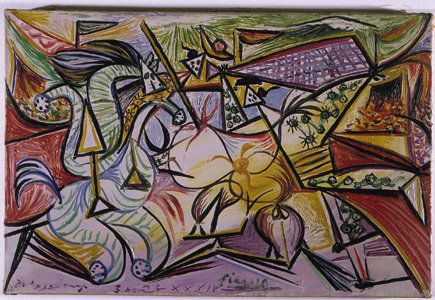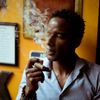
I'd like to use this space to revisit a three-way intersection: Art, the Arts, and Policy. It's familiar enough to create an easy deception, often driven by the summary cliché, "Art has Power." We also count on a solid history from agit prop to banned books and persecuted artists to make the overlap clear.
But, it's exactly because we've reached the "power" cliché that I think it's time to deconstruct the idea in order to uncover back stories on the processes, the players, and the impact surrounding Art. We might then get to new and more interesting stuff, alternately disturbing and invigorating accounts of failures and triumphs on the heels of Art as probably the biggest influence on how we live.
First, let's plant some definitions:
- Art: I'm taking license here in Art with a capital "A," defined broadly as work through various media that touches a basic human sensibility on a profound level. (Art, then, is as unpredictable in its full effect as we are.)
- The Arts: The mass of people and institutions concerned with promoting and commercializing Art for whatever reason, be it aesthetic, charitable, educational, etc.
- Policy: Extending my license, I'm combining politics, government and the people subject to them as one mass of Policy, with the people not just observing but, as a singular force defining common thought.
Now, let's start with a seemingly cut-and-dried example, Pablo Picasso and his painting, "Guernica": Commissioned by the Spanish government, unveiled at The World Expo 1937 in Paris, exiled from Spain by Picasso himself (to the care of New York's MOMA) on the condition of full democracy being implemented, and received by Spain in 1981 -- this homecoming being protested by Picasso's heirs who questioned the bona fides of the newly democratized nation. Here is the argument in bold face: the work of Art in custody of The Arts, and speaking directly to Policy.
Or is it so clear? Picasso shrugged off direct political discourse when asked to explain the painting: "This bull is a bull and this horse is a horse... I make the painting for the painting. I paint the objects for what they are." He guards the weight of his work.
As obvious as the consensus opinion was and is -- the painting as a statement on the horror of war -- Picasso wouldn't put that ceiling of meaning on it, instead tossing everybody back into the abyss of dealing with it on very personal terms. This is Art. It ain't so easy. Right here is where we'll put in to examine what happens when Art is in play and the moments when it lands on the scene. Then, from both a current and historical view, we'll issue a few challenges.
- To Art: This one is age-old and clearly not mine, but we'll use it as a foundational premise: The challenge to Art is to continue to elude the artist. Art can't be guaranteed by process, or wouldn't we just write an app for it and shut down the museums?
- To The Arts: To not forget Art in the face of necessary commercialism, the pressure to confine itself to classes, and the reflex to simply be charitable when confronted with class.
- To Policy: To become aware of Art as the principal influence on how we, the people, think and live.
Resolving these challenges will let us cut loose the elephant from the corner and walk him around the room. We should knock over some pretty vases as we focus on the unexpected effects of Art, going past our corny attempts to confine it with a first meaning (see agit prop again) and past even our well-intentioned attempts to deploy it as a beachhead (see ping pong diplomacy).

Enough theory: I'd like to enter the theater by consulting the former U.S. ambassador to South Africa (1986-89), the United Nations (1992-93), and Australia (1993-96), The Honorable Edward J. Perkins, who was kind enough to sit for this photograph (below) I made during a break in our conversation at The Aspen Institue in Colorado:
Since my early studies of Asian philosophy and Graeco/Roman history, art has been a mandatory part of my decision making process. As a long serving diplomat I have been served by my limited knowledge of the place of art in the makeup of the community.
I was fortunate to have this limited knowledge during my time as United States ambassador in South Africa. Part of our efforts to seek unity amongst the black revolutionaries was to seek out the black artists in the several black communities. The results were overwhelming for we discovered black artists in every part of South Africa. It was through their art that I received my most vivid understanding of the societal damages inflicted by the political, social and economic system of apartheid. We began bringing black American artists and/or their works to South Africa for showing and for teaching. We insisted that all showings and appearances were to be in public places, open to South African blacks -- and other non-whites -- as well as whites. Government officials objected to this mingling of the races -- at first.
When we refused to permit the showing of United States government sponsored art displays on a segregated basis the South African government officials relented because they were eager to convince themselves and the outside world that Afrikaners were "cultured people."
We invited both black South African artists and Afrikaner artists to be our guests. During the first showing a well-known Afrikaner artist thanked me for sponsoring the event. "We did not know there were black artists in our country. We have had wonderful conversations tonight." It took awhile, but eventually the Afrikaner and black artists began to commune.
Wow... I won't even try to find words to complement a case that clear.
Going forward, I'll share dispatches from my own travels as I also chase this thing called Art and as I talk to a wide range of protagonists about... How could kwaito music still stir up South Africa? What does Australian aboriginal art matter to you? Banksy and rural Alabama... what gives? Was the UN's Guernica tapestry covered up as an unwelcome backdrop to the Iraq war buildup? Etc.
So, let's talk: Art, the Arts, and Policy.
